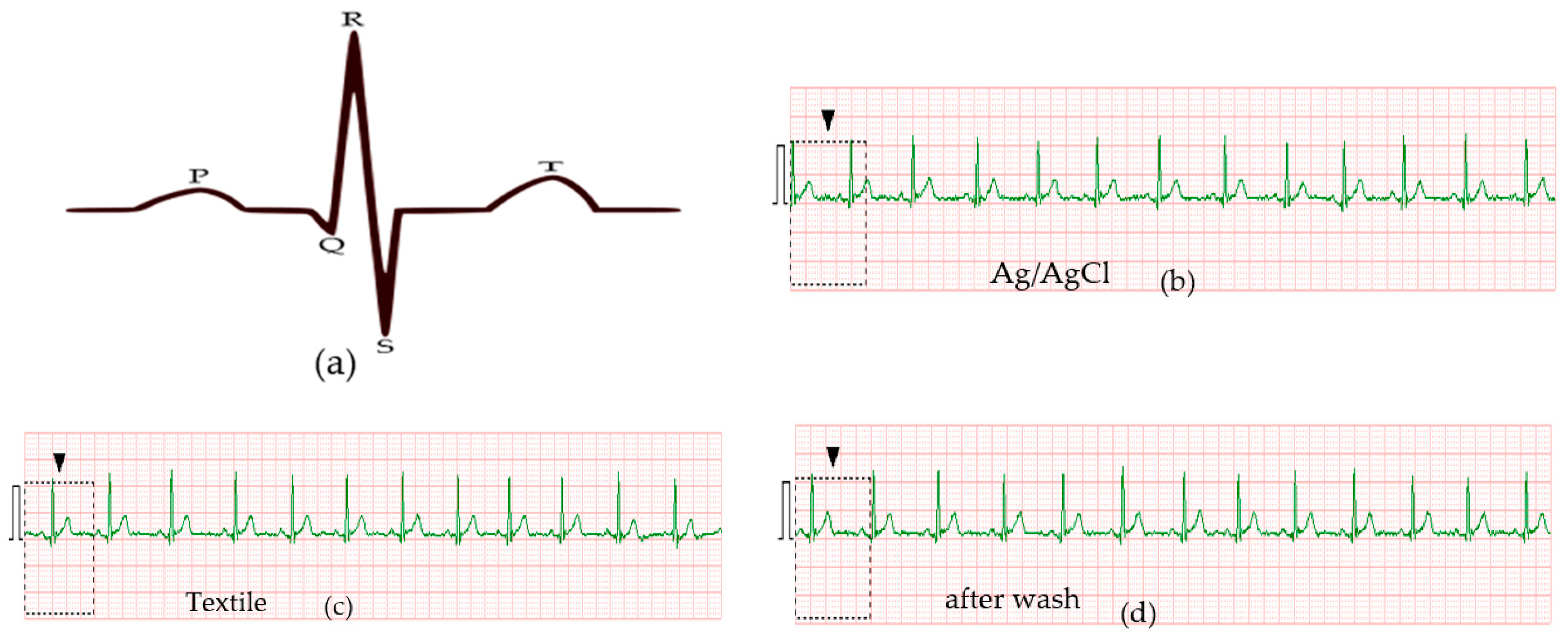A Washable Silver-Printed Textile Electrode for ECG Monitoring †
Abstract
:1. Introduction
2. Experimental
2.1. Materials and Sample Preparation
2.2. Electrical Conductivity Measurement
2.3. ECG Measurement
3. Results
4. Conclusions
Supplementary Materials
Author Contributions
Funding
Institutional Review Board Statement
Informed Consent Statement
Data Availability Statement
Conflicts of Interest
References
- Wang, Y.; Deepu, C.J.; Lian, Y. A Computationally Efficient QRS Detection Algorithm for Wearable ECG Sensors. In Proceedings of the Annual International Conference of the IEEE Engineering in Medicine and Biology Society, Boston, MA, USA, 30 August–3 September 2011; pp. 5641–5644. [Google Scholar]
- Koncar, V. Smart Textiles and Their Applications; Woodhead Publishing: Sawston, UK, 2016; ISBN 9780081005835. [Google Scholar]
- Abu-Saude, M.; Morshed, B.I. Characterization of a Novel Polypyrrole (PPy) Conductive Polymer Coated Patterned Vertical CNT (PvCNT) Dry ECG Electrode. Chemosensors 2018, 6, 27. [Google Scholar] [CrossRef] [Green Version]
- Xu, P.J.; Zhang, H.; Tao, X.M. Textile-Structured Electrodes for Electrocardiogram. Text. Prog. 2008, 40, 183–213. [Google Scholar] [CrossRef]
- Yapici, M.K.; Alkhidir, T.E. Intelligent Medical Garments with Graphene-Functionalized Smart-Cloth ECG Sensors. Sensors 2017, 17, 875. [Google Scholar] [CrossRef] [Green Version]
- Yokus, M.A.; Jur, J.S. Fabric-Based Wearable Dry Electrodes for Body Surface Biopotential Recording. IEEE Trans. Biomed. Eng. 2016, 63, 423–430. [Google Scholar] [CrossRef]
- Kazani, I.; Hertleer, C.; de Mey, G.; Schwarz, A.; Guxho, G.; van Langenhove, L. Electrical Conductive Textiles Obtained by Screen Printing. Fibres Text. East. Eur. 2012, 90, 57–63. [Google Scholar]
- Taji, B.; Shirmohammadi, S.; Groza, V.; Bolic, M. An ECG Monitoring System Using Conductive Fabric. In Proceedings of the 2013 IEEE International Symposium on Medical Measurements and Applications (MeMeA), Gatineau, QC, Canada, 4–5 May 2013; pp. 309–314. [Google Scholar] [CrossRef]

Publisher’s Note: MDPI stays neutral with regard to jurisdictional claims in published maps and institutional affiliations. |
© 2021 by the authors. Licensee MDPI, Basel, Switzerland. This article is an open access article distributed under the terms and conditions of the Creative Commons Attribution (CC BY) license (https://creativecommons.org/licenses/by/4.0/).
Share and Cite
Nigusse, A.B.; Malengier, B.; Mengistie, D.A.; Van Langenhove, L. A Washable Silver-Printed Textile Electrode for ECG Monitoring. Eng. Proc. 2021, 6, 63. https://doi.org/10.3390/I3S2021Dresden-10139
Nigusse AB, Malengier B, Mengistie DA, Van Langenhove L. A Washable Silver-Printed Textile Electrode for ECG Monitoring. Engineering Proceedings. 2021; 6(1):63. https://doi.org/10.3390/I3S2021Dresden-10139
Chicago/Turabian StyleNigusse, Abreha Bayrau, Benny Malengier, Desalegn Alemu Mengistie, and Lieva Van Langenhove. 2021. "A Washable Silver-Printed Textile Electrode for ECG Monitoring" Engineering Proceedings 6, no. 1: 63. https://doi.org/10.3390/I3S2021Dresden-10139
APA StyleNigusse, A. B., Malengier, B., Mengistie, D. A., & Van Langenhove, L. (2021). A Washable Silver-Printed Textile Electrode for ECG Monitoring. Engineering Proceedings, 6(1), 63. https://doi.org/10.3390/I3S2021Dresden-10139







